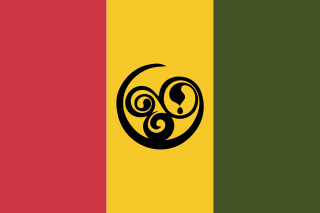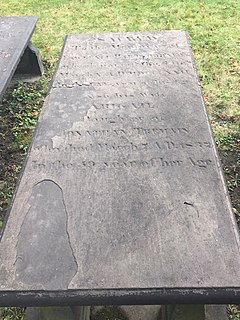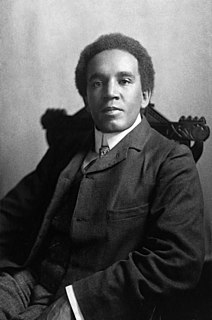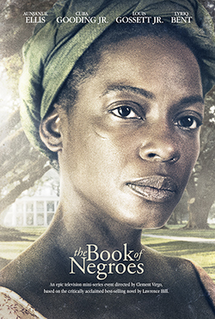Related Research Articles

Black Loyalists were people of African descent who sided with the Loyalists during the American Revolutionary War. In particular, the term refers to men who escaped enslavement by Patriot masters and served on the Loyalist side because of the Crown's guarantee of freedom.
Thomas Peters, born Thomas Potters, was a veteran of the Black Pioneers, fighting for the British in the American Revolutionary War. A Black Loyalist, he was resettled in Nova Scotia, where he became a politician and one of the "Founding Fathers" of the nation of Sierra Leone in West Africa. Peters was among a group of influential Black Canadians who pressed the Crown to fulfill its commitment for land grants in Nova Scotia. Later they recruited African-American settlers in Nova Scotia for the colonisation of Sierra Leone in the late eighteenth century.

Black Nova Scotians are Black Canadians whose ancestors primarily date back to the Colonial United States as slaves or freemen, later arriving in Nova Scotia, Canada, during the 18th and early 19th centuries. As of the 2016 Census of Canada, 21,915 Black people live in Nova Scotia, most in Halifax. Since the 1950s, numerous Black Nova Scotians have migrated to Toronto for its larger range of opportunities. Before the immigration reforms of 1967, Black Nova Scotians formed 37% of the total Black Canadian population.

John Marrant was one of the first African-American preachers and missionaries in North America. Born free in New York City, he moved as a child with his family to Charleston, South Carolina. His father died when he was young, and he and his mother also lived in Florida and Georgia. After escaping to the Cherokee, with whom he lived for two years, he allied with the British during the American Revolutionary War and resettled afterward in London. There he became involved with the Countess of Huntingdon's Connexion and ordained as a preacher.
The Philipsburg Proclamation is a historical document issued by British Army General Sir Henry Clinton on 30 June 1779, intended to encourage slaves to run away and enlist in the Royal Forces.

David George was an African-American Baptist preacher and a Black Loyalist from the American South who escaped to British lines in Savannah, Georgia; later he accepted transport to Nova Scotia and land there. He eventually resettled in Freetown, Sierra Leone. With other slaves, George founded the Silver Bluff Baptist Church in South Carolina in 1775, the first black congregation in the present-day United States. He was later affiliated with the First African Baptist Church of Savannah, Georgia. After migration, he founded Baptist congregations in Nova Scotia and Freetown, Sierra Leone. George wrote an account of his life that is one of the most important early slave narratives.
Boston King was a former American slave and Black Loyalist, who gained freedom from the British and settled in Nova Scotia after the American Revolutionary War. He later immigrated to Sierra Leone, where he helped found Freetown and became the first Methodist missionary to African indigenous people.
Harry Washington was a Black Loyalist in the American Revolutionary War, and enslaved by Virginia planter George Washington, later the first President of the United States. When the war was lost the British then evacuated him to Nova Scotia. In 1792 he joined nearly 1,200 freedmen for resettlement in Sierra Leone, where they set up a colony of free people of color.

The Book of Negroes is a document created by Brigadier General Samuel Birch, under the direction of Sir Guy Carleton, that records names and descriptions of 3,000 Black Loyalists, enslaved Africans who escaped to the British lines during the American Revolution and were evacuated to points in Nova Scotia as free people of colour.
Moses "Daddy" Wilkinson or "Old Moses" was known as a Black Loyalist who gained freedom from slavery in Virginia during the American Revolutionary War, was a Wesleyan Methodist preacher in New York and Nova Scotia, and migrated in 1791 to Sierra Leone. There he established the first Methodist church in Settler Town and survived a rebellion in 1800.

Birchtown is a community and National Historic Site in the Canadian province of Nova Scotia, located near Shelburne in the Municipal District of Shelburne County. Founded in 1783, the village was the largest settlement of Black Loyalists and the largest free settlement of ethnic Africans in North America in the eighteenth century. The two other significant Black Loyalist communities established in Nova Scotia were Brindley town and Tracadie. Birchtown was named after British Brigadier General Samuel Birch, an official who helped lead the evacuation of Black Loyalists from New York.

The Nova Scotian Settlers, or Sierra Leone Settlers were African-Americans who founded the settlement of Freetown, Sierra Leone and the Colony of Sierra Leone, on March 11, 1792. The majority of these black American immigrants were among 3,000 African-Americans, mostly former slaves, who had sought freedom and refuge with the British during the American Revolutionary War, leaving rebel masters. They became known as the Black Loyalists. The Nova Scotian settlers were jointly led by African-American Thomas Peters, a former soldier, and English abolitionist John Clarkson. For most of the 19th century, the Settlers resided in Settler Town and remained a distinct ethnic group within the Freetown territory, tending to marry among themselves and with Europeans in the colony.

Stephen Blucke or Stephen Bluck was a Black Loyalist, in the American Revolutionary War, and one the commanding officers, of the British Loyalist provincial unit, the Black Company of Pioneers. He was one of 3,000 people who left New York for Nova Scotia on British ships. He settled in a town designed for African-Americans, Birchtown, Nova Scotia. He was a leader in the town, called a magistrate and commissioned as lieutenant colonel of the Black Militia of the greater Shelburne district by Governor Governor John Parr. He worked with a surveyor to identify the area that would become Birchtown and was involved in coordinating labour for roads and other public works. He lived the life of a middle-class person while his neighbors lived a life of poverty. He had a substantial well-built house, while most people lived in simple housing. He was a go-between for employment of some of the townspeople in labor or similar jobs.
William Gwinn was an African American from Boston, Massachusetts. He was one of the first black Americans to participate in the antebellum American Back-to-Africa movement under the auspices of Captain Paul Cuffe's 1815 voyage to Sierra Leone.

The Sierra Leone Creole people are an ethnic group of Sierra Leone. The Sierra Leone Creole people are descendants of freed African-American, Afro-Caribbean, and Liberated African slaves who settled in the Western Area of Sierra Leone between 1787 and about 1885. The colony was established by the British, supported by abolitionists, under the Sierra Leone Company as a place for freedmen. The settlers called their new settlement Freetown. Today, the Sierra Leone Creoles are 1.2 percent of the population of Sierra Leone.

The Book of Negroes is a 2015 television miniseries based on the 2007 novel of the same name by Canadian writer Lawrence Hill. The book was inspired by the British freeing and evacuation of former slaves, known as Black Loyalists, who had left rebel masters during the American Revolutionary War. The British transported some 3,000 Black Loyalists to Nova Scotia for resettlement, documenting their names in what was called the Book of Negroes.
The Shelburne riots were attacks in July 1784 by landless Loyalist veterans of the American War of Independence against Black Loyalists and government officials in the town of Shelburne, Nova Scotia, and the nearby village of Birchtown. They have been characterized as the first race riots in Canada, and one of the earliest recorded race riots in North America.
Abraham Hazeley (1784–1847) was a Nova Scotian settler in Sierra Leone. He was the founder of what was to become one of the most prominent Creole families in the country.

Deborah Squash was a slave on George Washington's Mount Vernon plantation before she escaped in 1781. She went to New Amsterdam, which was the headquarters for the British during the American Revolution. At the end of the war, she was one of the 3,000 blacks in the Book of Negroes that sailed on a British ship for Nova Scotia.
Jane Jackson Thompson was an enslaved person who lived with her common-law husband, Talbot Thompson, until he was able to purchase her freedom in 1769. Talbot was a successful sail-maker and provided a comfortable life for Jane and their family.
References
- ↑ "Davis Surname Meaning and Distribution". Retrieved 23 January 2014
- ↑ "Last name:Davies". SurnameDB. Retrieved 28 April 2021.
- ↑ "Book of Negroes - Book One Part One". Black Loyalist, Canada's Digital Collection. November 17, 2007. Archived from the original on November 17, 2007. Retrieved March 20, 2020.
- ↑ "Birchtown Muster". Black Loyalist, Canada's Digital Collection. Retrieved March 20, 2020.
- ↑ Herrmann, Rachel B. (2019-11-15). No Useless Mouth: Waging War and Fighting Hunger in the American Revolution. Cornell University Press. p. 1797. ISBN 978-1-5017-1612-6.